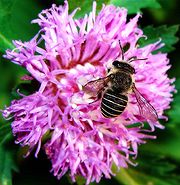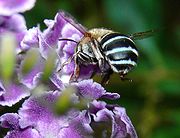
Australian native bees
Encyclopedia



Bee
Bees are flying insects closely related to wasps and ants, and are known for their role in pollination and for producing honey and beeswax. Bees are a monophyletic lineage within the superfamily Apoidea, presently classified by the unranked taxon name Anthophila...
. http://www.aussiebee.com.au/faq.html#Anchor-Q5-14210 Bees can be distinguished from flies
Fly
True flies are insects of the order Diptera . They possess a pair of wings on the mesothorax and a pair of halteres, derived from the hind wings, on the metathorax...
in that bees have four wing
Wing
A wing is an appendage with a surface that produces lift for flight or propulsion through the atmosphere, or through another gaseous or liquid fluid...
s, where flies have only two. http://www.aussiebee.com.au/faq.html#Anchor-Q14-21683 Bees collect pollen
Pollen
Pollen is a fine to coarse powder containing the microgametophytes of seed plants, which produce the male gametes . Pollen grains have a hard coat that protects the sperm cells during the process of their movement from the stamens to the pistil of flowering plants or from the male cone to the...
, from flower
Flower
A flower, sometimes known as a bloom or blossom, is the reproductive structure found in flowering plants . The biological function of a flower is to effect reproduction, usually by providing a mechanism for the union of sperm with eggs...
s, to feed their young. Wasp
Wasp
The term wasp is typically defined as any insect of the order Hymenoptera and suborder Apocrita that is neither a bee nor an ant. Almost every pest insect species has at least one wasp species that preys upon it or parasitizes it, making wasps critically important in natural control of their...
s and flies do not do this, although they may be seen eating pollen, so identification is not always easy.
Sting or no sting, solitary vs social
Ten of the species, the social native bees TrigonaTrigona (genus)
Trigona is the largest genus of stingless bees, formerly including many more subgenera than the present assemblage; many of these former subgenera have been elevated to generic status. There are approximately 150 species presently included in the genus, in 11 subgenera...
and Austroplebeia have no sting
Stingless bee
Stingless bees, sometimes called stingless honey bees or simply meliponines, are a large group of bees, comprising the tribe Meliponini . They belong in the family Apidae, and are closely related to common honey bees, carpenter bees, orchid bees and bumblebees...
. http://www.aussiebee.com.au/faq.html#Anchor-Q5-14210
Of the remainder, which live solitary lives, none are aggressive, and most cannot actually use their sting
Bee sting
A bee sting is strictly a sting from a bee . In the vernacular it can mean a sting of a bee, wasp, hornet, or yellow jacket. Some people may even call the bite of a horse-fly a bee sting...
on human
Human
Humans are the only living species in the Homo genus...
s because they are too small to do so. Larger examples of Australian native bee are capable of stinging if handled or squashed.
The stings of most Australian native species of bee will cause relatively minor discomfort to most people -- "not as painful as those of a bull ant or paper wasp
Paper wasp
Paper wasps are -long wasps that gather fibers from dead wood and plant stems, which they mix with saliva, and use to construct water-resistant nests made of gray or brown papery material...
and last only a few minutes". However, they may sting more than once, and can cause an allergic reaction
Anaphylaxis
Anaphylaxis is defined as "a serious allergic reaction that is rapid in onset and may cause death". It typically results in a number of symptoms including throat swelling, an itchy rash, and low blood pressure...
-- increasing effect associated with repeated exposure to the antigen
Antigen
An antigen is a foreign molecule that, when introduced into the body, triggers the production of an antibody by the immune system. The immune system will then kill or neutralize the antigen that is recognized as a foreign and potentially harmful invader. These invaders can be molecules such as...
.
Honey
Social species of Australian native bees do produce honey, but not much, as they are relatively primitive bee species. In cool-climate areas of Australia, all the honey the bees produce is needed by the swarm to live through winter.Collecting honey from Australian native bee nests can cause many of the bees to drown in spilt honey. The honey is tangy in comparison with commercial honey taken from the European Honey bee. The bees store their honey in "small resinous pots which look like bunches of grapes".
Pollination
The different species of Australian native bee have different habits and preferences in gathering pollen, so different species are better pollinatorPollinator
A pollinator is the biotic agent that moves pollen from the male anthers of a flower to the female stigma of a flower to accomplish fertilization or syngamy of the female gamete in the ovule of the flower by the male gamete from the pollen grain...
s of a given plant than other species. Research is currently underway into use of Amegilla
Amegilla
Amegilla is a genus of bees in the tribe Anthophorini. A few species have blue metallic bands on the abdomen, and are referred to as "Blue banded bees"....
("blue-banded bees") for use in pollinating hydroponic tomato
Tomato
The word "tomato" may refer to the plant or the edible, typically red, fruit which it bears. Originating in South America, the tomato was spread around the world following the Spanish colonization of the Americas, and its many varieties are now widely grown, often in greenhouses in cooler...
es, while some hydroponic growers are petition
Petition
A petition is a request to do something, most commonly addressed to a government official or public entity. Petitions to a deity are a form of prayer....
ing for introduction to the Australian mainland of the European bumblebee, Bombus terrestris
Bombus terrestris
Bombus terrestris, the buff-tailed bumblebee or large earth bumblebee is one of the most numerous bumblebee species in Europe. The queen is 2–2.7 cm long, while the workers are 1½–2 cm...
-- the island/continent Australia has a history of sensationally poor outcomes from introduced species
Introduced species
An introduced species — or neozoon, alien, exotic, non-indigenous, or non-native species, or simply an introduction, is a species living outside its indigenous or native distributional range, and has arrived in an ecosystem or plant community by human activity, either deliberate or accidental...
, the most famous example being that of the cane toad Bufo marinus -- so the question of use of native vs introduced bees for pollination in Australia is controversial. http://www.aussiebee.com.au/bumblebees-8may06.html

